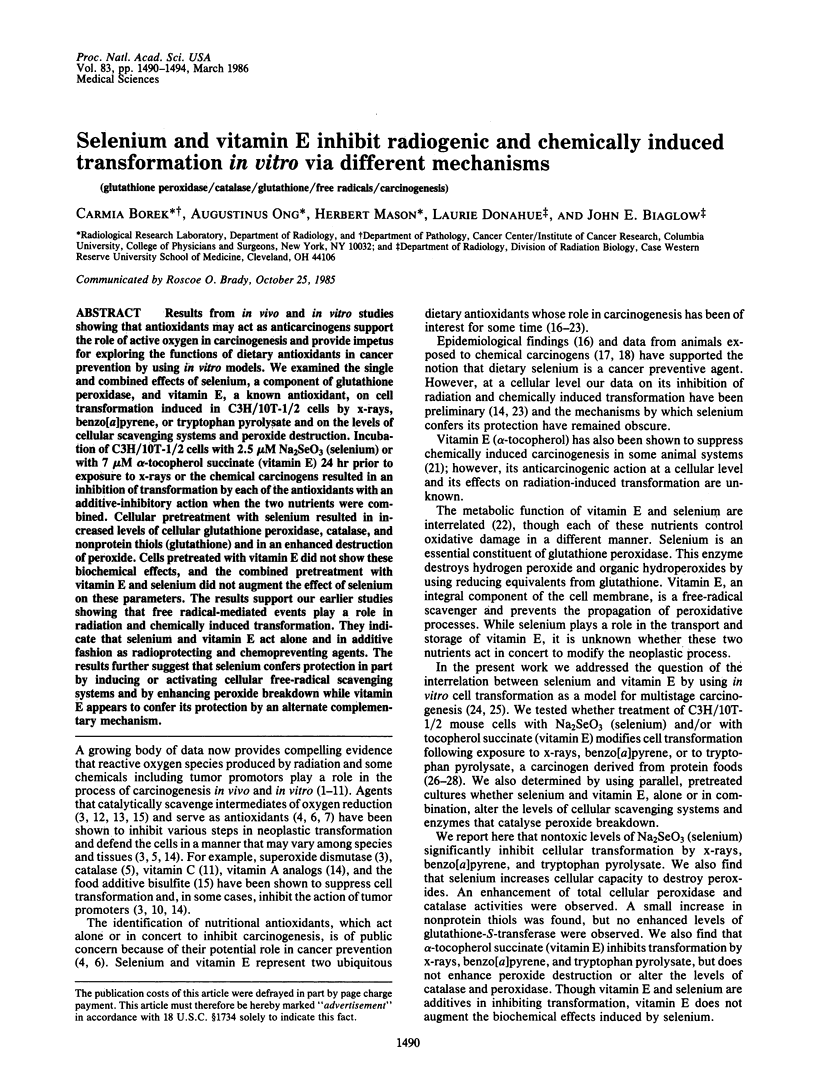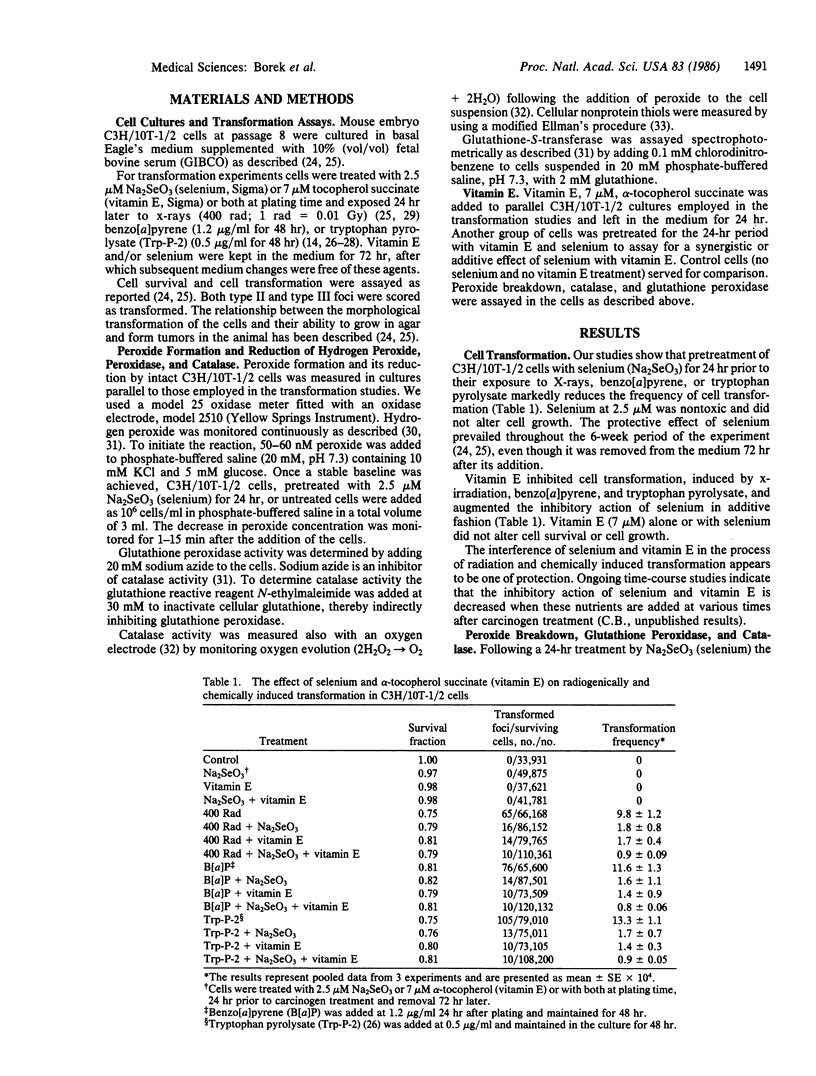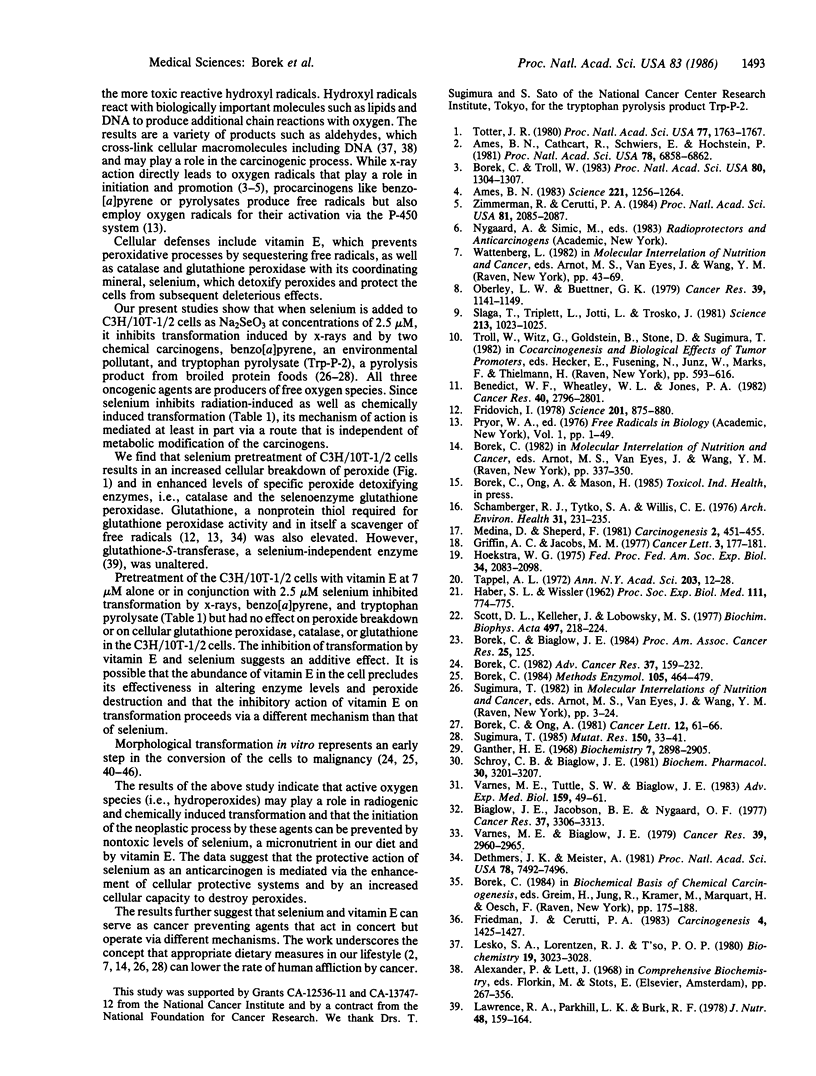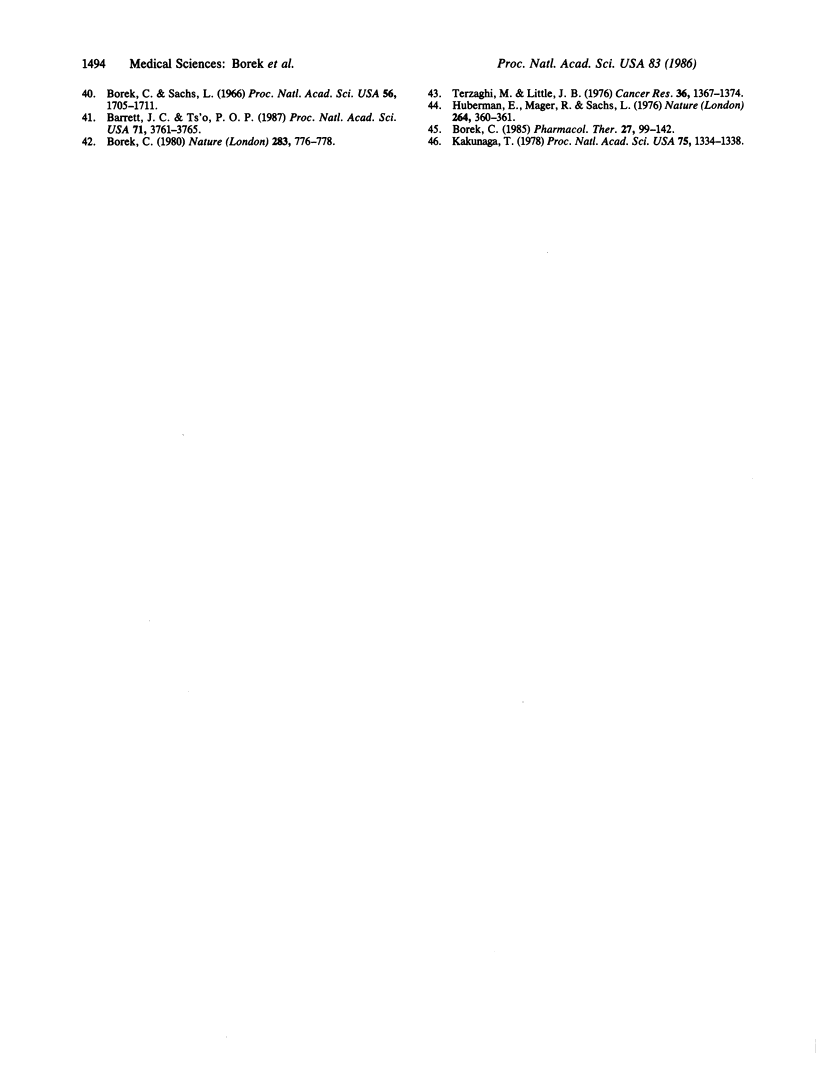Abstract
Results from in vivo and in vitro studies showing that antioxidants may act as anticarcinogens support the role of active oxygen in carcinogenesis and provide impetus for exploring the functions of dietary antioxidants in cancer prevention by using in vitro models. We examined the single and combined effects of selenium, a component of glutathione peroxidase, and vitamin E, a known antioxidant, on cell transformation induced in C3H/10T-1/2 cells by x-rays, benzo[a]pyrene, or tryptophan pyrolysate and on the levels of cellular scavenging systems and peroxide destruction. Incubation of C3H/10T-1/2 cells with 2.5 microM Na2SeO3 (selenium) or with 7 microM alpha-tocopherol succinate (vitamin E) 24 hr prior to exposure to x-rays or the chemical carcinogens resulted in an inhibition of transformation by each of the antioxidants with an additive-inhibitory action when the two nutrients were combined. Cellular pretreatment with selenium resulted in increased levels of cellular glutathione peroxidase, catalase, and nonprotein thiols (glutathione) and in an enhanced destruction of peroxide. Cells pretreated with vitamin E did not show these biochemical effects, and the combined pretreatment with vitamin E and selenium did not augment the effect of selenium on these parameters. The results support our earlier studies showing that free radical-mediated events play a role in radiation and chemically induced transformation. They indicate that selenium and vitamin E act alone and in additive fashion as radioprotecting and chemopreventing agents. The results further suggest that selenium confers protection in part by inducing or activating cellular free-radical scavenging systems and by enhancing peroxide breakdown while vitamin E appears to confer its protection by an alternate complementary mechanism.
Full text
PDF




Selected References
These references are in PubMed. This may not be the complete list of references from this article.
- Ames B. N., Cathcart R., Schwiers E., Hochstein P. Uric acid provides an antioxidant defense in humans against oxidant- and radical-caused aging and cancer: a hypothesis. Proc Natl Acad Sci U S A. 1981 Nov;78(11):6858–6862. doi: 10.1073/pnas.78.11.6858. [DOI] [PMC free article] [PubMed] [Google Scholar]
- Ames B. N. Dietary carcinogens and anticarcinogens. Oxygen radicals and degenerative diseases. Science. 1983 Sep 23;221(4617):1256–1264. doi: 10.1126/science.6351251. [DOI] [PubMed] [Google Scholar]
- Benedict W. F., Wheatley W. L., Jones P. A. Inhibition of chemically induced morphological transformation and reversion of the transformed phenotype of ascorbic acid in C3H/10T 1/2 cells. Cancer Res. 1980 Aug;40(8 Pt 1):2796–2801. [PubMed] [Google Scholar]
- Biaglow J. E., Jacobson B. E., Nygaard O. F. Metabolic reduction of 4-nitroquinoline N-oxide and other radical-producing drugs to oxygen-reactive intermediates. Cancer Res. 1977 Sep;37(9):3306–3313. [PubMed] [Google Scholar]
- Borek C. In vitro cell cultures as tools in the study of free radicals and free radical modifiers in carcinogenesis. Methods Enzymol. 1984;105:464–479. doi: 10.1016/s0076-6879(84)05065-5. [DOI] [PubMed] [Google Scholar]
- Borek C., Ong A. The interaction of ionizing radiation and food pyrolysis products in producing oncogenic transformation in vitro. Cancer Lett. 1981 Mar;12(1-2):61–66. doi: 10.1016/0304-3835(81)90038-0. [DOI] [PubMed] [Google Scholar]
- Borek C. Radiation oncogenesis in cell culture. Adv Cancer Res. 1982;37:159–232. doi: 10.1016/s0065-230x(08)60884-2. [DOI] [PubMed] [Google Scholar]
- Borek C., Sachs L. The difference in contact inhibition of cell replication between normal cells and cells transformed by different carcinogens. Proc Natl Acad Sci U S A. 1966 Dec;56(6):1705–1711. doi: 10.1073/pnas.56.6.1705. [DOI] [PMC free article] [PubMed] [Google Scholar]
- Borek C. The induction and control of radiogenic transformation in vitro: cellular and molecular mechanisms. Pharmacol Ther. 1985;27(1):99–142. doi: 10.1016/0163-7258(85)90066-x. [DOI] [PubMed] [Google Scholar]
- Borek C., Troll W. Modifiers of free radicals inhibit in vitro the oncogenic actions of x-rays, bleomycin, and the tumor promoter 12-O-tetradecanoylphorbol 13-acetate. Proc Natl Acad Sci U S A. 1983 Mar;80(5):1304–1307. doi: 10.1073/pnas.80.5.1304. [DOI] [PMC free article] [PubMed] [Google Scholar]
- Borek C. X-ray induced in vitro neoplastic transformation of human diploid cells. Nature. 1980 Feb 21;283(5749):776–778. doi: 10.1038/283776a0. [DOI] [PubMed] [Google Scholar]
- Dethmers J. K., Meister A. Glutathione export by human lymphoid cells: depletion of glutathione by inhibition of its synthesis decreases export and increases sensitivity to irradiation. Proc Natl Acad Sci U S A. 1981 Dec;78(12):7492–7496. doi: 10.1073/pnas.78.12.7492. [DOI] [PMC free article] [PubMed] [Google Scholar]
- Fridovich I. The biology of oxygen radicals. Science. 1978 Sep 8;201(4359):875–880. doi: 10.1126/science.210504. [DOI] [PubMed] [Google Scholar]
- Friedman J., Cerutti P. The induction of ornithine decarboxylase by phorbol 12-myristate 13-acetate or by serum is inhibited by antioxidants. Carcinogenesis. 1983 Nov;4(11):1425–1427. doi: 10.1093/carcin/4.11.1425. [DOI] [PubMed] [Google Scholar]
- Ganther H. E. Selenotrisulfides. Formation by the reaction of thiols with selenious acid. Biochemistry. 1968 Aug;7(8):2898–2905. doi: 10.1021/bi00848a029. [DOI] [PubMed] [Google Scholar]
- Griffin A. C., Jacobs M. M. Effects of selenium on azo dye hepatocarcinogenesis. Cancer Lett. 1977 Sep;3(3-4):177–181. doi: 10.1016/s0304-3835(77)95431-3. [DOI] [PubMed] [Google Scholar]
- Hoekstra W. G. Biochemical function of selenium and its relation to vitamin E. Fed Proc. 1975 Oct;34(11):2083–2089. [PubMed] [Google Scholar]
- Huberman E., Mager R., Sachs L. Mutagenesis and transformation of normal cells by chemical carcinogens. Nature. 1976 Nov 25;264(5584):360–361. doi: 10.1038/264360a0. [DOI] [PubMed] [Google Scholar]
- Kakunaga T. Neoplastic transformation of human diploid fibroblast cells by chemical carcinogens. Proc Natl Acad Sci U S A. 1978 Mar;75(3):1334–1338. doi: 10.1073/pnas.75.3.1334. [DOI] [PMC free article] [PubMed] [Google Scholar]
- Lesko S. A., Lorentzen R. J., Ts'o P. O. Role of superoxide in deoxyribonucleic acid strand scission. Biochemistry. 1980 Jun 24;19(13):3023–3028. doi: 10.1021/bi00554a029. [DOI] [PubMed] [Google Scholar]
- Medina D., Shepherd F. Selenium-mediated inhibition of 7,12-dimethylbenz[a]anthracene-induced mouse mammary tumorigenesis. Carcinogenesis. 1981;2(5):451–455. doi: 10.1093/carcin/2.5.451. [DOI] [PubMed] [Google Scholar]
- Oberley L. W., Buettner G. R. Role of superoxide dismutase in cancer: a review. Cancer Res. 1979 Apr;39(4):1141–1149. [PubMed] [Google Scholar]
- Schroy C. B., Biaglow J. E. Use of an oxidase electrode to determine factors affecting the in vitro production of hydrogen peroxide by Ehrlich cells and 1-chloro-2, 4-dinitrobenzene. Biochem Pharmacol. 1981 Dec 1;30(23):3201–3207. doi: 10.1016/0006-2952(81)90519-0. [DOI] [PubMed] [Google Scholar]
- Scott D. L., Kelleher J., Losowsky M. S. The influence of dietary selenium and vitamin E on glutathione peroxidase and glutathione in the rat. Biochim Biophys Acta. 1977 Mar 29;497(1):218–224. doi: 10.1016/0304-4165(77)90154-4. [DOI] [PubMed] [Google Scholar]
- Shamberger R. J., Tytko S. A., Willis C. E. Antioxidants and cancer. Part VI. Selenium and age-adjusted human cancer mortality. Arch Environ Health. 1976 Sep-Oct;31(5):231–235. doi: 10.1080/00039896.1976.10667225. [DOI] [PubMed] [Google Scholar]
- Slaga T. J., Klein-Szanto A. J., Triplett L. L., Yotti L. P., Trosko K. E. Skin tumor-promoting activity of benzoyl peroxide, a widely used free radical-generating compound. Science. 1981 Aug 28;213(4511):1023–1025. doi: 10.1126/science.6791284. [DOI] [PubMed] [Google Scholar]
- Sugimura T. Carcinogenicity of mutagenic heterocyclic amines formed during the cooking process. Mutat Res. 1985 Jun-Jul;150(1-2):33–41. doi: 10.1016/0027-5107(85)90098-3. [DOI] [PubMed] [Google Scholar]
- Tappel A. L. Vitamin E and free radical peroxidation of lipids. Ann N Y Acad Sci. 1972 Dec 18;203:12–28. doi: 10.1111/j.1749-6632.1972.tb27851.x. [DOI] [PubMed] [Google Scholar]
- Terzaghi M., Little J. B. X-radiation-induced transformation in a C3H mouse embryo-derived cell line. Cancer Res. 1976 Apr;36(4):1367–1374. [PubMed] [Google Scholar]
- Totter J. R. Spontaneous cancer and its possible relationship to oxygen metabolism. Proc Natl Acad Sci U S A. 1980 Apr;77(4):1763–1767. doi: 10.1073/pnas.77.4.1763. [DOI] [PMC free article] [PubMed] [Google Scholar]
- Varnes M. E., Biaglow J. E. Interactions of the carcinogen 4-nitroquinoline 1-oxide with the non-protein thiols of mammalian cells. Cancer Res. 1979 Aug;39(8):2960–2965. [PubMed] [Google Scholar]
- Varnes M. E., Tuttle S. W., Biaglow J. E. The use of a peroxidase electrode to measure the effects of nitro compounds on intact cells. Adv Exp Med Biol. 1983;159:49–61. doi: 10.1007/978-1-4684-7790-0_5. [DOI] [PubMed] [Google Scholar]
- Zimmerman R., Cerutti P. Active oxygen acts as a promoter of transformation in mouse embryo C3H/10T1/2/C18 fibroblasts. Proc Natl Acad Sci U S A. 1984 Apr;81(7):2085–2087. doi: 10.1073/pnas.81.7.2085. [DOI] [PMC free article] [PubMed] [Google Scholar]


